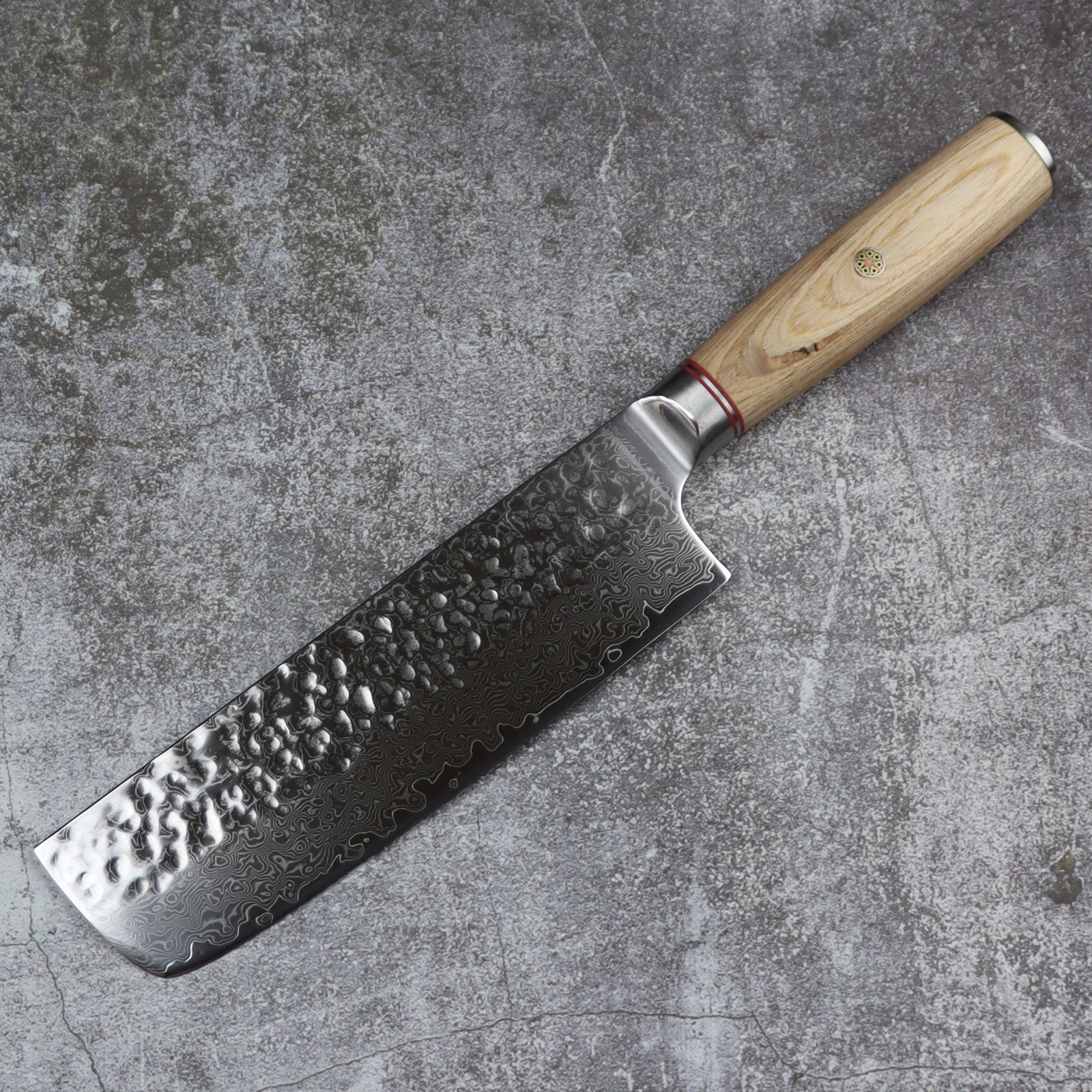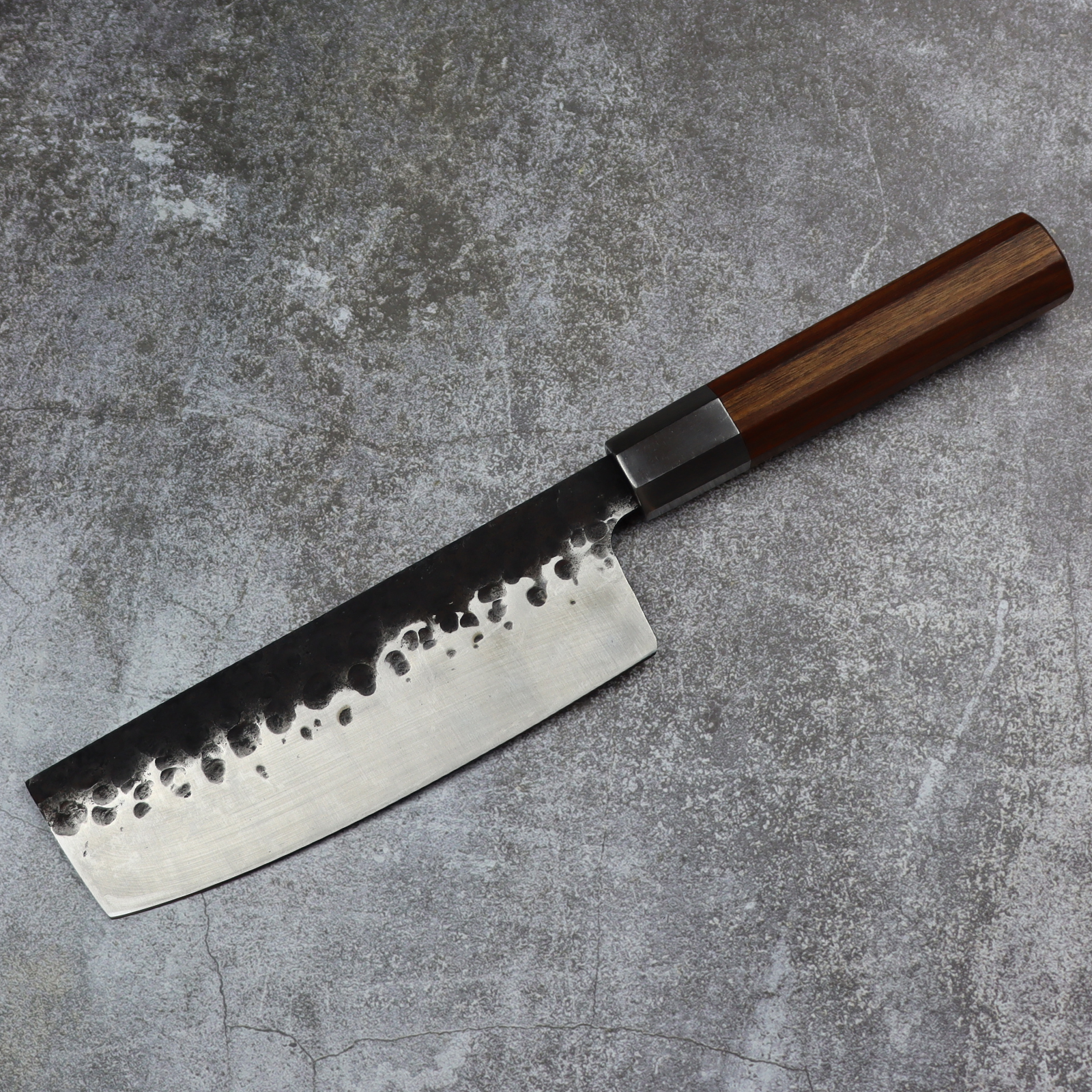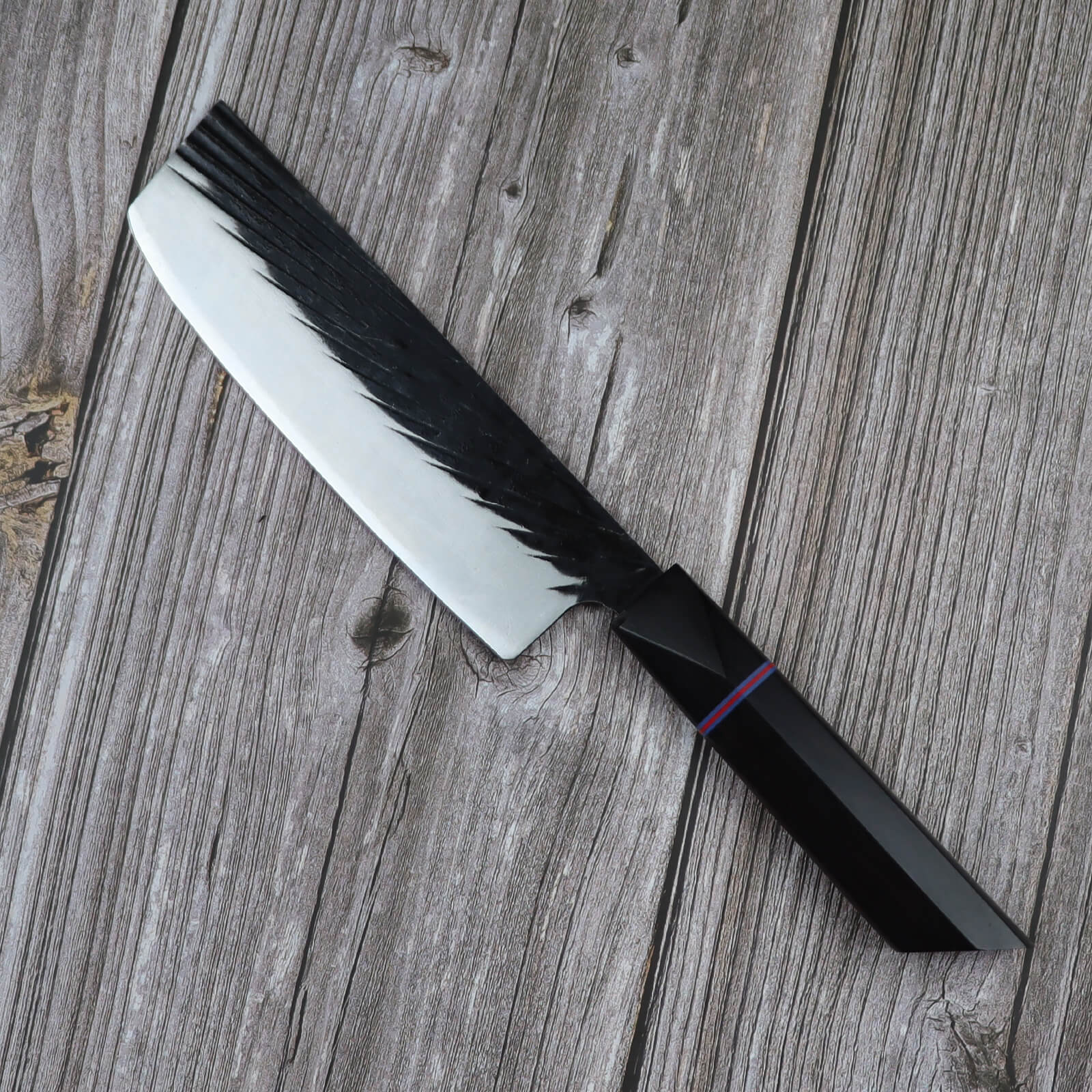Are you ready to elevate your vegetable prep game to new heights? Meet the Nakiri knife – the unsung hero of the culinary world, beloved by vegetarians and chefs alike. Nakiri knife originates from Japan and has become synonymous with precision and finesse in the art of vegetable preparation. It is also called Japanese vegetable knives. Whether you're slicing pounds of vegetables for a vibrant sala or chopping potatoes and carrots for a comforting beef stew, the Nakiri is your ultimate companion. Now, let's delve into the world of Nakiri knives.

Nakiri Knife Meaning
A Nakiri knife is a Japanese-style vegetable knife. Nakiri knives, with their distinctive flat edge and squared-off tips, are designed for effortlessly gliding through vegetables with precision and accuracy. The key feature of Nakiri is its broad, rectangular, straight-edged blade with a squared-off tip, allowing for complete contact with the cutting board and resulting in clean cuts through the skin of vegetables.
The Nakiri knife has a double-beveled edge, The thin blade of Nakiri makes it ideal for peeling, slicing, chopping, mincing, and creating decorative cuts on various vegetables. Compared to traditional Western-style knives, the Nakiri excels in vegetable preparation but is not suitable for cutting hard items like bones. It is a popular choice among home cooks in Japan and has recently become popular in Western countries. It is often referred to as the "master of vegetables," with its full name, Nakiri bōchō, translating to "leaf cutter".
How to Use a Nakiri Knife?
Nakiri excels at the Japanese 'push forward/Pull Back' cutting techniques rather than rocking, however, it is also great for slicing, chopping, and mincing. Now, let's explore why it is like this.
The Nakiri knife boasts a rectangular shape with a flat edge and minimal curvature towards the tip, facilitating straight push cutting with precision, while its wider blade with the added weight of the blade allows the knife to effortlessly penetrate through food with minimal exertion, enhancing efficiency and reducing fatigue for the user. In addition, here are some tips on push-cutting:
Use a Forward and Downward Motion: Slice effortlessly with the Nakiri knife by moving it forward and downward while keeping the blade perpendicular to the cutting board. Apply gentle pressure and let the sharp edge glide through the vegetable.
Maintain a Consistent Cutting Angle: Maintain a steady cutting angle for uniform slices, ensuring an appealing presentation for your dish.
What is a Japanese Nakiri Knife Used for?
Primarily designed for vegetable preparation, Nakiri knives are best suited for items such as peppers, cabbage, onions, and various fruits. With its balanced weight distribution, the Nakiri effortlessly glides through even the hardest vegetables like squash, pumpkins, and potatoes, ensuring precise cuts every time. Say goodbye to the accordion cut!
But what truly sets the Nakiri apart is its ability to handle precision tasks with finesse. Whether you're julienning carrots, creating delicate brunoise cuts, or crafting paper-thin garnishes for dishes like sashimi, the straight blade design of the Nakiri delivers unmatched accuracy. And let's not forget the aesthetic appeal it brings to your culinary creations – the clean and uniform cuts achieved with the Nakiri knife enhance the presentation of salads, stir-fries, and vegetable side dishes, elevating them from simple fare to culinary delights.
But hold on, there's an extra trick up the Nakiri knife's sleeve! It's fantastic at a technique called "mill chopping."Mill chopping involves gently tapping a sharp blade onto a small pile of herbs, garlic, shallots, or ginger with speed and precision. simply let the Nakiri's sharp edge do the work for you without turning them into mush.
The Nakiri knife makes vegetable prep tasks effortless and enjoyable for cooks of all skill levels.
Why Choose Nakiri Knives?
You may have a question: is a Nakiri knife worth it? Ok, here are some reasons that you can choose Nakiri in your kitchen.
Precision Cutting: Whether you're julienning carrots or finely dicing onions, The Nakiri's flat blade and balanced weight distribution allow for precise cuts, ensuring consistent cuts every time.
Efficiency: Its straight blade design and sharp edge make it highly efficient for cutting vegetables. You'll find that you can breeze through your chopping and slicing tasks with ease, saving time and effort in the kitchen.
Versatility: While Nakiri is designed for vegetables, it still works well on fruits and meats.
Ease of Use: Crafted with comfort in mind, Nakiri knives feature ergonomic handles and balanced weight distribution, reducing fatigue during prolonged kitchen sessions.
Is a Santoku Better Than a Nakiri?
It is a preference issue, but we'll let you know the difference between Santoku and Nakiri.

1. Blade Design
Nakiri Knife: The Nakiri knife has a straight, double-edged blade with a flat tip. It's great for precise cuts on veggies.
Santoku Knife: The Santoku knife has a wider, curved blade with a sheep's foot tip. It's versatile for slicing veggies and meats with ease.
2. Cutting Technique
Nakiri Knife: Use the Nakiri knife with a straightforward up-and-down chopping motion, perfect for veggies.
Santoku Knife: The Santoku knife works well for various cutting techniques like slicing, dicing, and mincing.
3. Versatility
Nakiri Knife: It's primarily designed for vegetables, even tough ones like squash or sweet potatoes.
Santoku Knife: While it's good for veggies, its wider blade also makes it suitable for slicing meats and fish.
4. Blade Thickness and Weight
Nakiri Knife: It's light and has a thin blade, offering precise control for vegetable cuts.
Santoku Knife: Slightly heavier with a thicker blade, providing stability for cutting meats and denser ingredients.
5. Personal Preference
Choose based on what you cook most. If it's mainly veggies and you prefer straight chopping, go for the Nakiri. If you want a more versatile knife for both veggies and meats, the Santoku is a great option.
Usuba VS Nakiri
In general, the Usuba serves as the single bevel edged alternative to the Nakiri. It's commonly employed for raw garnishes and techniques such as delicately peeling thin sheets of daikon radishes using a rotary motion. Here are detailed differences between them:

Usuba
Design: The Usuba knife is a traditional Japanese vegetable knife with a single bevel edge, typically used by professional chefs in Japanese cuisine.
Blade Shape: It features a long, rectangular blade with a flat profile and a sharp, straight edge.
Purpose: The Usuba knife is specifically designed for precise vegetable cutting techniques, such as making intricate cuts for garnishes or decorative presentations.
Skill Level: Due to its single bevel edge and specialized design, the Usuba knife requires skill and experience to use effectively. It's commonly found in professional kitchens where chefs have undergone extensive training in Japanese culinary techniques.
Nakiri Knife
Design: The Nakiri knife is a versatile Japanese vegetable knife with a double bevel edge, commonly used by both professional chefs and home cooks.
Blade Shape: It features a shorter, rectangular blade with a flat profile and a sharp, straight edge, similar to the Usuba knife but with a double bevel.
Purpose: The Nakiri knife is designed for general vegetable preparation tasks, including slicing, chopping, and mincing. It excels at creating precise and uniform cuts for a wide variety of vegetables.
Skill Level: The Nakiri knife is more user-friendly and forgiving compared to the Usuba knife, making it suitable for cooks of all skill levels. Its double bevel edge allows for easier maintenance and sharpening.
What to Look for in a Nakiri Knife?
Blade Material: Opt for Nakiri knives crafted from high-quality steel, such as VG-10 or AUS-10, for exceptional sharpness and durability.
Blade Thickness: Consider the thickness of the blade based on your cutting preferences; thinner blades provide precision, while thicker blades offer stability.
Handle Material: Choose a handle material that suits your grip preference and aesthetic taste, whether it's classic wooden handles or modern composite materials.
Balance: Look for a knife with a balanced weight distribution between the blade and handle, allowing for effortless control and maneuverability.
Size: Consider the size of the Nakiri knife based on your preferences and the types of vegetables you commonly prepare. While most Nakiri knives have blade lengths ranging from 6 to 7 inches, choose a size that feels comfortable and manageable for your hand size and kitchen tasks.
Frequently Asked Questions
Are Nakiri Knives Suitable for Boning?
No, Nakiri knives aren't suitable for boning. If you want to tackle your bones, you can refer to our cleaver knife collection.
Is a Nakiri Knife Suitable for Cutting Meat?
Nakiri knives are indeed very sharp and versatile, thus it can work well on cutting through proteins, but avoid using them on near bones and frozen meat. The solid surface of bones can potentially damage or chip the blade.
What's the Right Cutting Method for Nakiri?
As we mentioned above, The right cutting method for a Nakiri knife involves a push-forward and pull-back motion rather than a rock motion.
Are Nakiri Knives Suitable for Both Right-handed and Left-handed Users?
Yes, Nakiri knives are suitable for both right-handed and left-handed users. Their symmetrical blade design and double bevel edge make them versatile and accommodating to users of either hand orientation.
What is the Ideal Size for a Nakiri Knife?
The best size depends on individual preferences and the specific tasks you'll be using the knife for in your kitchen. The ideal size for a Nakiri knife typically ranges from 6 to 7 inches in blade length.
How to Maintain and Care for Your Nakiri Knife?
Cleaning: Hand wash your knife immediately after use and dry it thoroughly to prevent corrosion.
Sharpening: Regularly hone your Nakiri knife using a whetstone or honing rod to maintain its razor-sharp edge.
Storage: Store your Nakiri knife in a knife block or on a magnetic strip to protect the blade and prevent accidents.
How to Sharpen a Nakiri?
When choosing a sharpening tool, consider factors such as your skill level and your preferred sharpening method. Whetstones offer control and versatility, sharpening systems provide consistency, electric sharpeners offer convenience, honing rods maintain sharpness, and pull-through sharpeners are handy for quick touch-ups. Select the tool that best suits your needs and preferences to keep your knives sharp and ready for use.
Best Nakiri Knives
For vegans, vegetable enthusiasts, or those who frequently prepare large quantities of veggies, Fzkaly's Nakiri knives offer an affordable yet high-quality solution.
Known for their meticulous craftsmanship, Fzkaly Nakiri knives are crafted from top-grade high-carbon stainless steel or Damascus steel, ensuring razor-sharp precision in every cut. Whether you're slicing delicate vegetables or precisely dicing meats and fish, the Nakiri knife effortlessly handles a variety of kitchen tasks with finesse. With a Fzkaly Nakiri knife, you'll breeze through your culinary creations, enjoying the perfect balance of versatility and precision in every slice.




